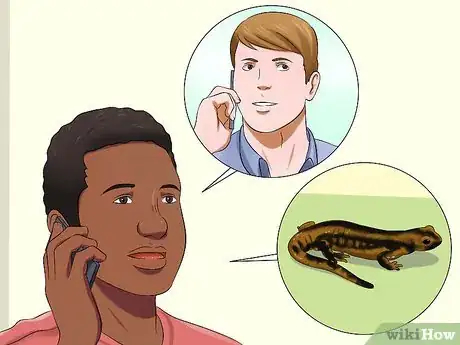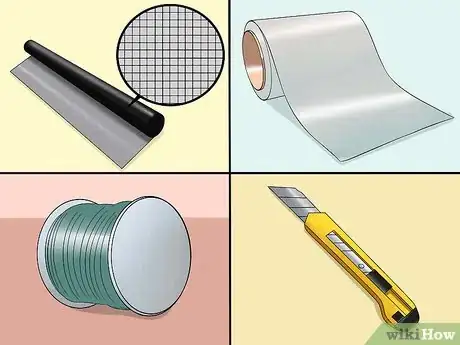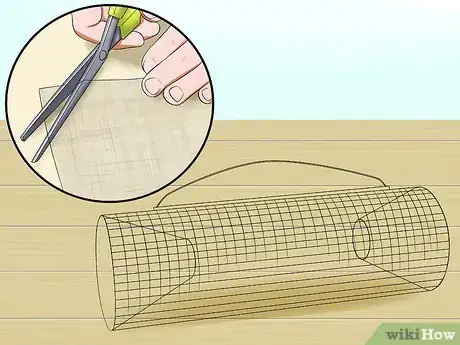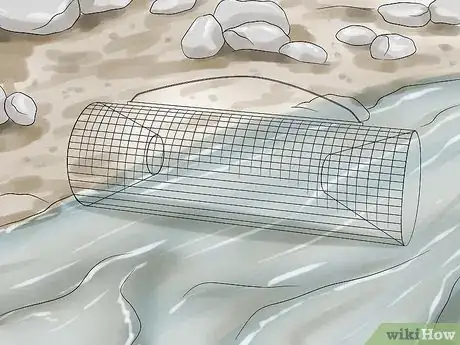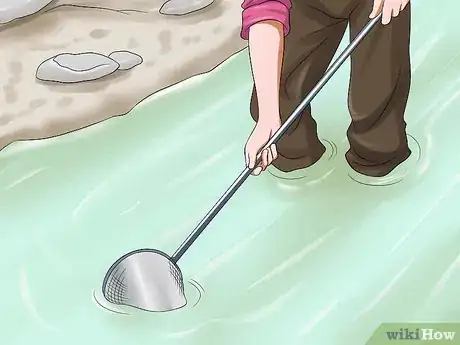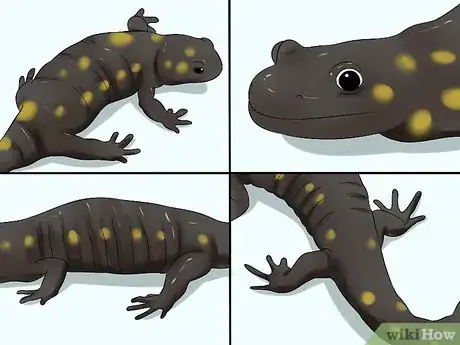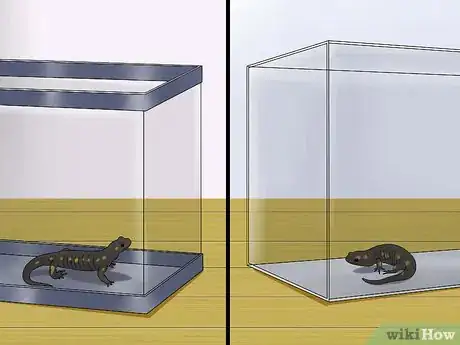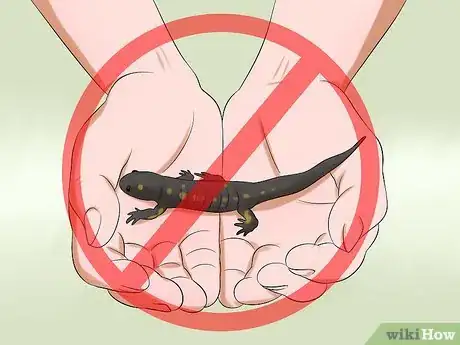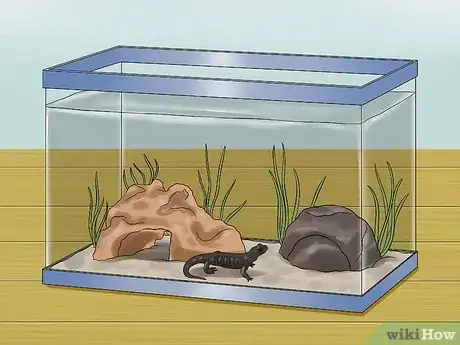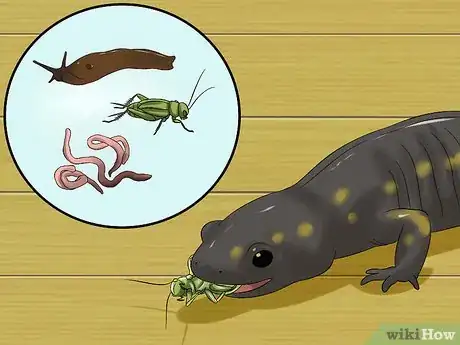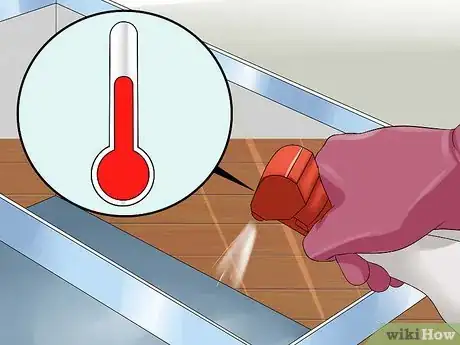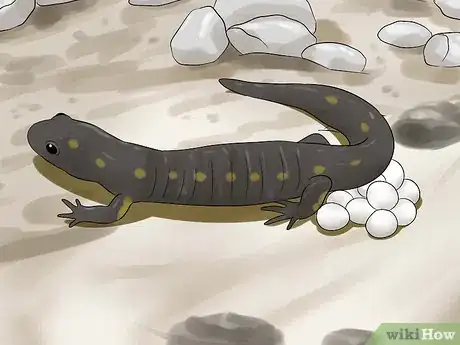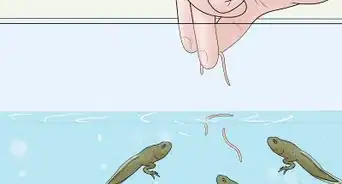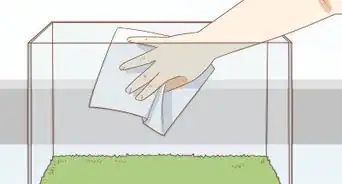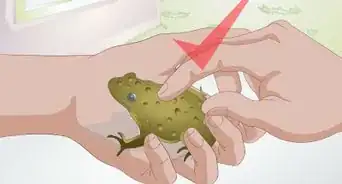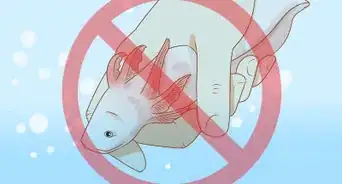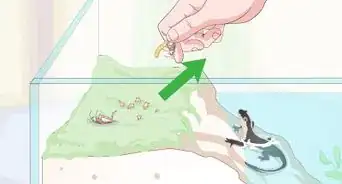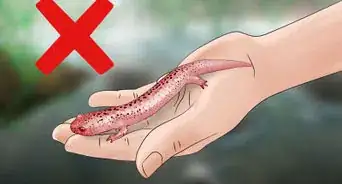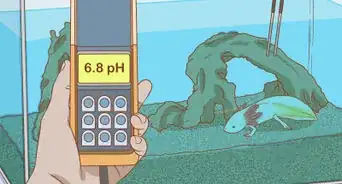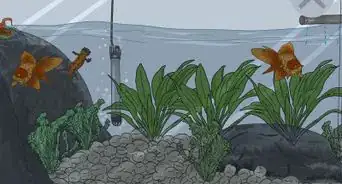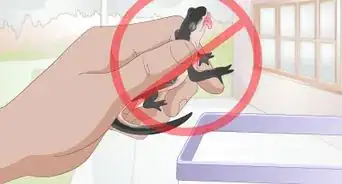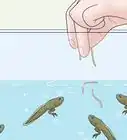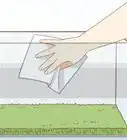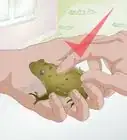This article was co-authored by wikiHow Staff. Our trained team of editors and researchers validate articles for accuracy and comprehensiveness. wikiHow's Content Management Team carefully monitors the work from our editorial staff to ensure that each article is backed by trusted research and meets our high quality standards.
There are 7 references cited in this article, which can be found at the bottom of the page.
This article has been viewed 106,371 times.
Learn more...
Salamanders, which some people refer to as newts, are amphibians that have inhabited the earth for millions of years.[1] There are about 350 different species and types of salamanders, all of which are carnivorous and none of which make sounds.[2] Although salamanders are not typical pets, in part because they shouldn’t be handled, you may enjoy watching them in an aquarium in your home.[3] By carefully capturing a salamander and caring for it properly, you can enjoy these beautiful creatures.
Steps
Capturing a Salamander
-
1Learn about salamanders. Get to know something about salamander behavior before you catch them. This can help you more effectively catch a salamander or many of them without harming the animal.[4] Contact your local county extension to help identify salamanders in your local area. Some facts to know about salamanders you should learn are:
- they are completely harmless to people and plants
- most don’t grow beyond 6 inches
- they are smooth-skinned
- they live in moist places like under rocks, logs, and in mulch.
- healthy salamanders will be skittish around humans.[5]
-
2Collect trapping equipment. It can be fairly easy to trap salamanders in ponds or near other bodies of water. By putting together trapping materials before you start, you can effectively catch your salamander(s). You’ll need the following items:
- 24 ft. of 18 inch wide aluminum window screening or 15 ft. of 28 inch wide screening for the cylinders
- 15 ft. of 36 inch wide fiberglass screening for the funnels
- 25 ft. of string or small rope for the handles
- Utility knife and scissors for cutting the screen and rope
- Stapler with 1000 staples
- A small fish net if you want to catch or other container, such as a jar with some water in it. Make sure it has holes in the lid so the salamander can breathe.
- A glow stick or outdoor light bulb, which studies have shown can be an effective bait for trapping amphibians.[6]
Advertisement -
3Construct a funnel trap. Although you can purchase commercially made funnel traps for salamanders, they may not be as effective as traps you make yourself. Using the material you gathered, put together your funnel trap and place it in the water to catch your new pets.
- Cut a rectangular piece of aluminum window screening using the scissors or utility knife for the cylinders.
- Roll the cut piece of screening into a cylinder 18” long and 8” in diameter. Leave a 1” lip on the top of the cylinder by holding the 18” end and rolling it towards the other end.
- Staple the 1” screening lip along the base of the lip where it meets the cylinder screening to hold the cylinder and lip together.
- Cut out two funnels from the fiberglass screening with a 9” opening on the wide end, and 1 ¾” opening on the narrow end of each piece. Roll the wide ends of the funnels over the outside edges of the cylinder and staple every ½” with the stapler.
- Attach a 30” string handle to the lip and attach it with duct tape to both ends of the 1” aluminum lip.
-
4
-
5Check your traps. Within twenty-four hours of setting your traps, see if you’ve caught any salamanders. You may also capture species other than salamanders and can return these to the wild. If the trap is empty, leave it in place and continue to check until you find a salamander.
- Take a plastic bag or jar with pinholes or a bucket of water to catch and transfer your salamander to its new habitat.
-
6Net a salamander. If you choose to actively net a salamander instead of using funnel traps, find them in the same places where you would set traps. Consider using a glow stick to attract salamanders into your net.[12]
- Wear a pair of waders or tall water proof pants so you can walk out into water.
- Sweep the net through the water by holding the net from the handle. Run the net, hoop first, through the water down-angled into the muck at the bottom of the pond or stream.
-
7Observe the salamander’s health. When you catch a salamander, check its health before you take it home to its new habitat. This can ensure that it doesn’t die or introduce diseases to a currently salamander colony you have.[13] The following traits indicate a healthy salamander:
- Plump but not bloated
- No visible bones in the rib, abdominal, or hip area
- Clear skin with no cuts, scratches, or discolored patches
- Clear and alert eyes
- No secretions or inflammation.[14]
Caring for Your Salamander
-
1Quarantine new animals. If you have an established colony of salamanders, quarantine your new animals for a few weeks. This can ensure that they are healthy and don’t wipe out any other animals with disease.[15]
-
2Avoid handling salamanders. As adorable as salamanders are, it is very important to not handle them unless absolutely necessary, such as transferring the animal to its new habitat. Secretions, salt and heat from human skin or substances on it can harm salamanders.[18]
-
3Transfer your salamander to her new habitat. Once you’ve checked the health of your salamander, you are ready to move her to her new habitat. Giving her a clean and fun environment may help her live for up to 20 years.[22] Your habitat should include:
- a clean aquarium large enough to accommodate all of your salamanders
- two to three inches of sloped and washed aquarium gravel to line the tank
- plants that have been washed so they don’t introduce diseases or fungi to the salamanders
- a sufficient source of sunlight
- a water filter
- a lid.[23]
-
4Feed your salamander. All species of salamanders are carnivores but may eat their meals very slowly.[24] Salamanders eat different types of animals depending on their size; larger salamanders will go for larger prey. Give your salamander food on alternate days five days a week.[25] These foods can include:
-
5Clean the habitat. Salamander enclosures are havens for bacteria and fungi.[28] Keep your salamander’s aquarium very clean to maintain her health and prevent the growth of harmful organisms.[29]
- Place a water filter in the aquarium to keep the water clean between more thorough disinfection.[30]
- Disinfect the aquarium with hot, soapy water every couple of weeks or more often if you notice it is dirty. Transfer the salamanders to holding tanks while you’re cleaning.
- Make sure to rinse the aquarium thoroughly so any residue doesn’t harm your salamander.[31]
-
6
Community Q&A
-
QuestionI want to raise a Red-backed salamander (Plethedon Cinereus). Where do I find those? And can they harm children?
 Silver PawsCommunity AnswerPlethodon Cinereus live in most places around eastern North America, throughout Canada and the US. You can find them in most marshlands and bog-type environments. They don't have much of a threat to kids besides the chance of salmonella. To avoid this, make sure you wash your hands after touching the newt or its tank area.
Silver PawsCommunity AnswerPlethodon Cinereus live in most places around eastern North America, throughout Canada and the US. You can find them in most marshlands and bog-type environments. They don't have much of a threat to kids besides the chance of salmonella. To avoid this, make sure you wash your hands after touching the newt or its tank area. -
QuestionCan I handle a salamander with gloves on?
 Community AnswerYes, but it's still best to minimize handling in order to minimize stress. Gloves protect the animal from your skin's acid mantle, but not from being terrified of a gigantic predatory mammal.
Community AnswerYes, but it's still best to minimize handling in order to minimize stress. Gloves protect the animal from your skin's acid mantle, but not from being terrified of a gigantic predatory mammal. -
QuestionWill crayfish attack salamanders?
 Community AnswerIf the crayfish are big enough then they will attack and sometimes kill salamanders.
Community AnswerIf the crayfish are big enough then they will attack and sometimes kill salamanders.
Warnings
- Some species of salamanders are federally protected. Catching or harming them may be considered a crime or require special permits. Consult your local government if you are uncertain.⧼thumbs_response⧽
- Never attempt an aquatic capture in bodies of water with swift currents.⧼thumbs_response⧽
References
- ↑ http://www.anapsid.org/sallies.html
- ↑ http://animals.sandiegozoo.org/animals/salamander-and-newt
- ↑ http://animals.sandiegozoo.org/animals/salamander-and-newt
- ↑ http://www.anapsid.org/sallies.html
- ↑ http://www.anapsid.org/sallies.html
- ↑ http://scholarship.richmond.edu/cgi/viewcontent.cgi?article=1014&context=biology-faculty-publications
- ↑ http://www.anapsid.org/sallies.html
- ↑ http://www.anapsid.org/sallies.html
- ↑ http://www.anapsid.org/sallies.html
- ↑ http://www.anapsid.org/sallies.html
- ↑ https://www.nwf.org/Wildlife/Wildlife-Library/Amphibians-Reptiles-and-Fish/Tiger-Salamander.aspx
- ↑ http://scholarship.richmond.edu/cgi/viewcontent.cgi?article=1014&context=biology-faculty-publications
- ↑ http://www.anapsid.org/sallies.html
- ↑ http://www.anapsid.org/sallies.html
- ↑ http://www.anapsid.org/sallies.html
- ↑ http://www.anapsid.org/sallies.html
- ↑ http://www.anapsid.org/sallies.html
- ↑ http://www.anapsid.org/sallies.html
- ↑ http://www.anapsid.org/sallies.html
- ↑ http://www.anapsid.org/sallies.html
- ↑ http://www.anapsid.org/sallies.html
- ↑ http://animals.sandiegozoo.org/animals/salamander-and-newt
- ↑ http://www.anapsid.org/sallies.html
- ↑ http://animals.sandiegozoo.org/animals/salamander-and-newt
- ↑ http://animals.sandiegozoo.org/animals/salamander-and-newt
- ↑ http://animals.sandiegozoo.org/animals/salamander-and-newt
- ↑ https://www.nwf.org/Wildlife/Wildlife-Library/Amphibians-Reptiles-and-Fish/Spotted-Salamander.aspx
- ↑ http://www.anapsid.org/sallies.html
- ↑ http://www.anapsid.org/sallies.html
- ↑ http://www.anapsid.org/sallies.html
- ↑ http://www.anapsid.org/sallies.html
- ↑ https://www.nwf.org/Wildlife/Wildlife-Library/Amphibians-Reptiles-and-Fish/Spotted-Salamander.aspx
- ↑ https://www.nwf.org/Wildlife/Wildlife-Library/Amphibians-Reptiles-and-Fish/Spotted-Salamander.aspx
- ↑ https://www.nwf.org/Wildlife/Wildlife-Library/Amphibians-Reptiles-and-Fish/Spotted-Salamander.aspx
- ↑ http://animals.sandiegozoo.org/animals/salamander-and-newt
About This Article
To catch a salamander, try attaching a glow stick to a fishing net, which will help attract nearby salamanders. Then, sweep the net through some water, like a pond or stream, so it's touching the bottom. You can also try catching a salamander with a funnel trap, which you can purchase or make on your own. Just place the trap at the bottom of some water or in a wooded area that's near stagnant water and check on it every day to see if you caught something. To learn how to take care of a salamander, scroll down!
